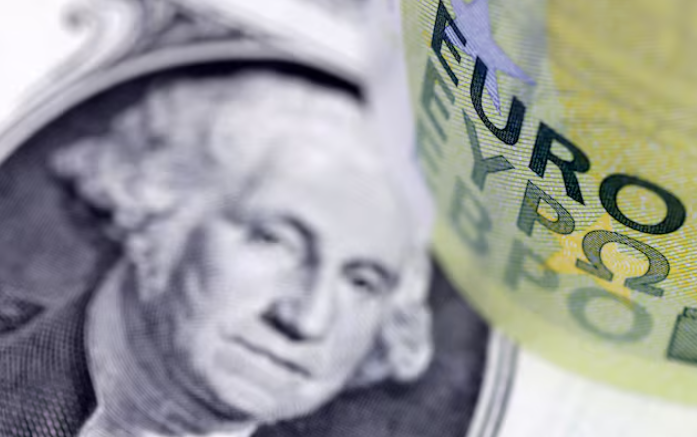Markets react mildly to Trump's latest tariff warning

By MG News | February 10, 2025 at 03:07 PM GMT+05:00
February 10, 2025 (MLN): Fresh threats of tariffs from U.S. President Donald Trump put pressure on the euro and the Australian and Canadian dollars in early Monday trading, though moves were less dramatic than last week's tariff-driven swings.
Trump said he would announce new 25% tariffs on all steel and aluminum imports into the U.S. later on Monday.
He also stated that reciprocal tariffs would be introduced on Tuesday or Wednesday, applying to all countries and matching the tariff rates levied by each nation, as Reuters reported.
The latest salvo adds to jitters over a global trade war, with China's retaliatory duties on U.S. goods due to take effect on Monday.
The Canadian dollar was among the biggest fallers among developed market currencies, with the dollar up 0.33% at C$1.4347.
Canada is a major exporter of steel and aluminum to the U.S.
The currency is still well off the C$1.4792 to the dollar that it touched a week ago in the aftermath of Trump's plan since postponed to impose 25% tariffs on all Canadian goods.
That rate was its weakest in over 20 years.
The euro dipped nearly 0.5% at one point in Asia trade but was last at $1.03125, 0.14% weaker, and the Australian dollar likewise pared early losses to last trade down 0.13% at $0.6269.
The euro dropped as low as $1.0125, a two-year low, last Monday at the height of that day's tariff fears, and the Aussie to a near-five-year low of $0.6086.
"Tariffs are back in focus," said Lee Hardman, senior currency analyst at MUFG.
"Last week, there was a bit of a reprieve for markets when he (Trump) held up from hiking on Canada and Mexico, but that looks like it was fairly short-lived."
Hardman also said the proposals for reciprocal tariffs "could potentially be more disruptive for global trade and the global economy, though depending on the exact details of that announcement."
The day's largest mover, however, was the Japanese yen, on which the dollar gained 0.7% to 152.43.
Hardman said this appeared to be a case of exhaustion after the Japanese currency had a strong last week in which the dollar fell from above 155 yen to under 151.
China's yuan hit its lowest in three weeks against the dollar, weakening past a key threshold as trade tensions weighed.
The onshore yuan weakened to 7.3074 to the dollar, breaching the psychologically important 7.3 per dollar level for the first time since January 20.
Beyond Trump, investor focus will be on U.S. inflation data set to be released on Wednesday.
Additionally, Federal Reserve Chair Jerome Powell will appear before the House of Representatives on Tuesday and Wednesday, with tariffs likely to be in the spotlight.
Analysts have said that tariffs could be inflationary and put further pressure on the Fed to keep interest rates elevated.
Markets are pricing in 36 basis points of cuts this year, down from 42 bps, after an upbeat payrolls report on Friday.
Copyright Mettis Link News
Related News
| Name | Price/Vol | %Chg/NChg |
|---|---|---|
| KSE100 | 128,199.43 336.91M |
2.05% 2572.11 |
| ALLSHR | 79,787.62 1,023.63M |
1.53% 1202.91 |
| KSE30 | 39,105.00 121.90M |
2.49% 951.21 |
| KMI30 | 186,915.61 131.16M |
1.10% 2029.11 |
| KMIALLSHR | 54,201.88 553.60M |
0.81% 438.07 |
| BKTi | 33,476.68 51.49M |
4.87% 1555.00 |
| OGTi | 27,962.58 9.77M |
0.68% 188.60 |
| Symbol | Bid/Ask | High/Low |
|---|
| Name | Last | High/Low | Chg/%Chg |
|---|---|---|---|
| BITCOIN FUTURES | 106,120.00 | 106,200.00 105,440.00 |
370.00 0.35% |
| BRENT CRUDE | 67.13 | 67.29 67.05 |
0.02 0.03% |
| RICHARDS BAY COAL MONTHLY | 97.50 | 97.50 97.50 |
0.70 0.72% |
| ROTTERDAM COAL MONTHLY | 103.80 | 103.80 103.80 |
-3.45 -3.22% |
| USD RBD PALM OLEIN | 998.50 | 998.50 998.50 |
0.00 0.00% |
| CRUDE OIL - WTI | 65.43 | 65.65 65.34 |
-0.02 -0.03% |
| SUGAR #11 WORLD | 15.70 | 16.21 15.55 |
-0.50 -3.09% |
Chart of the Day
Latest News
Top 5 things to watch in this week
Pakistan Stock Movers
| Name | Last | Chg/%Chg |
|---|
| Name | Last | Chg/%Chg |
|---|



.jpg)
 CPI
CPI